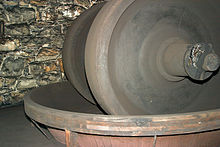Powder mill


A powder mill was a mill where gunpowder is made[1] from sulfur, saltpeter and charcoal.
Milling steps
Crude grinding and mixing operations such as the
- Charcoal was often manufactured nearby from locally available trees, but the heating retorts were typically separated from the other buildings to minimize fire danger. Trees with low value as sources of lumber were debarked, dried, and cut to uniform length to fit into iron retorts with cast iron doors. The retorts were carefully packed to leave as little air space as possible, and the retort doors were closed and sealed with clay to prevent entry of air as the retorts were heated by external fires. Volatile gas generated by the heating process was vented through a small flue at the top of each retort. After the external fires were extinguished, the retorts were allowed to cool before the doors were opened to remove the charcoal.[2]
- High purity sulfur usually required little preparation other than grinding to a powder. Separate grinding mills reduced cool charcoal and sulfur to fine powders.[2]
- Crude evaporative cooling would remove excess water. Purified potassium nitrate recrystallized while the cooling solution was gently agitated with broad hoes to prevent formation of large crystals.[2]
- Powdered sulfur and charcoal were combined in appropriate ratios with moist saltpeter crystals, and the moist paste was mixed and compacted by kneading beneath heavy rotating wheels in a press mill.[2][3]
- The compressed cake was transferred to a corning mill or kernelling mill to be cut into pieces of approximately correct size by bronze- or zinc-toothed wheels.[2]
- Kernelling mill products were sorted by size using leather sieves. Oversize product was returned to the kernelling mill, while undersize product was returned to the press mill.[2]
- Sorted kernels of desired size were dried and mixed with graphite to be tumbled in glazing mill barrels. Graphite coating reduced the tendency of grains to stick together in storage.[2]
- Glazed product was typically packaged in wooden kegs. Filled kegs were transported away from the mill as soon as possible to a powder magazine for wholesale distribution. The potential for destructive energy release from powder magazine accidents required the magazines to be distant from both the powder mill and other places of business or habitation.[2]
Explosions

Gunpowder is very easily ignited by static electricity or lightning strikes, and most powder mills experienced occasional accidental explosions. Powder mill explosions typically destroyed an entire building and killed those working in the vicinity of the building. Explosions might throw flaming debris which could ignite other buildings. Successful mills were typically built as an arrangement of separate buildings to minimize the loss from any single building explosion. Buildings were separated by enough distance to minimize the risk of being damaged by an explosion in an adjacent building. Buildings were usually built of stone with one weak wooden wall and roof to direct the force and debris from an accidental explosion toward a river or an open field.[2]
Power supply
Powder mills were originally powered by
In the United States
The 1810 census reported 208 powder mills in the United States.
Europe
Notable European mills include:
- Ballincollig Royal Gunpowder Mills, Cork, Ireland
- Faversham explosives industry, Faversham, England
- Grenelle Mill - France
- Poudrerie nationale de Vonges, Vonges, Côte-d'Or, France
- Waltham Abbey, Essex, England
References
- ^ Knight, Edward H.. "Powder-mill" Knight's new mechanical dictionary: a description of tools, instruments, machines, processes, and engineering: with indexical references to technical journals (1876-1880). vol. 2. Boston: Houghton, Mifflin and Co., 1883. 1781. Print.
- ^ a b c d e f g h i j k Whitten, Maurice M. (2012). The Gunpowder Mills of Gorham-Windham, Maine. Windham, Maine: Windham Historical Society. pp. 15–26.
- ^ Braddock, John. A memoir on gunpowder: in which are discussed, the principles both of its manufacture and proof.. Madras: Printed at the Church Mission Press, 1829. Print.
- ^ Rideal, Charles Frederick, and Freeman Morris. A century of success: the history of a great industry ; what it has accomplished ; a record of progress and sustained work : the E.I. du Pont de Nemours Powder Co., from its foundation to the present time. New York, N.Y.: Business America, 19111912. Print.
- ^ Wilson, Mark R. The business of civil war: military mobilization and the state, 1861-1865 (2006) JHU Press p.118
- ^ "Sibley Mill and Confederate Powder Works Chimney". National Park Service. Retrieved 10 June 2019.
- ^ Congressional Serial Set. United States Government Printing Office. 1912. p. 350.
- ^ Dunn, Tony. ".A catalog of .22 Boxes of the U.S.A." (PDF). Roger E. Huegel. Retrieved 14 November 2014.
- ^ Sullebarger Associates, PAST Architects. "Ahimaaz King House and Carriage House Historic Structure Report" (PDF). Deerfield Township, Ohio. Archived from the original (PDF) on 2 June 2012. Retrieved 29 November 2014.
- ^ Bridges, Toby. "Black Powder in America". North American Muzzleloader Hunting. Retrieved 15 June 2018.
